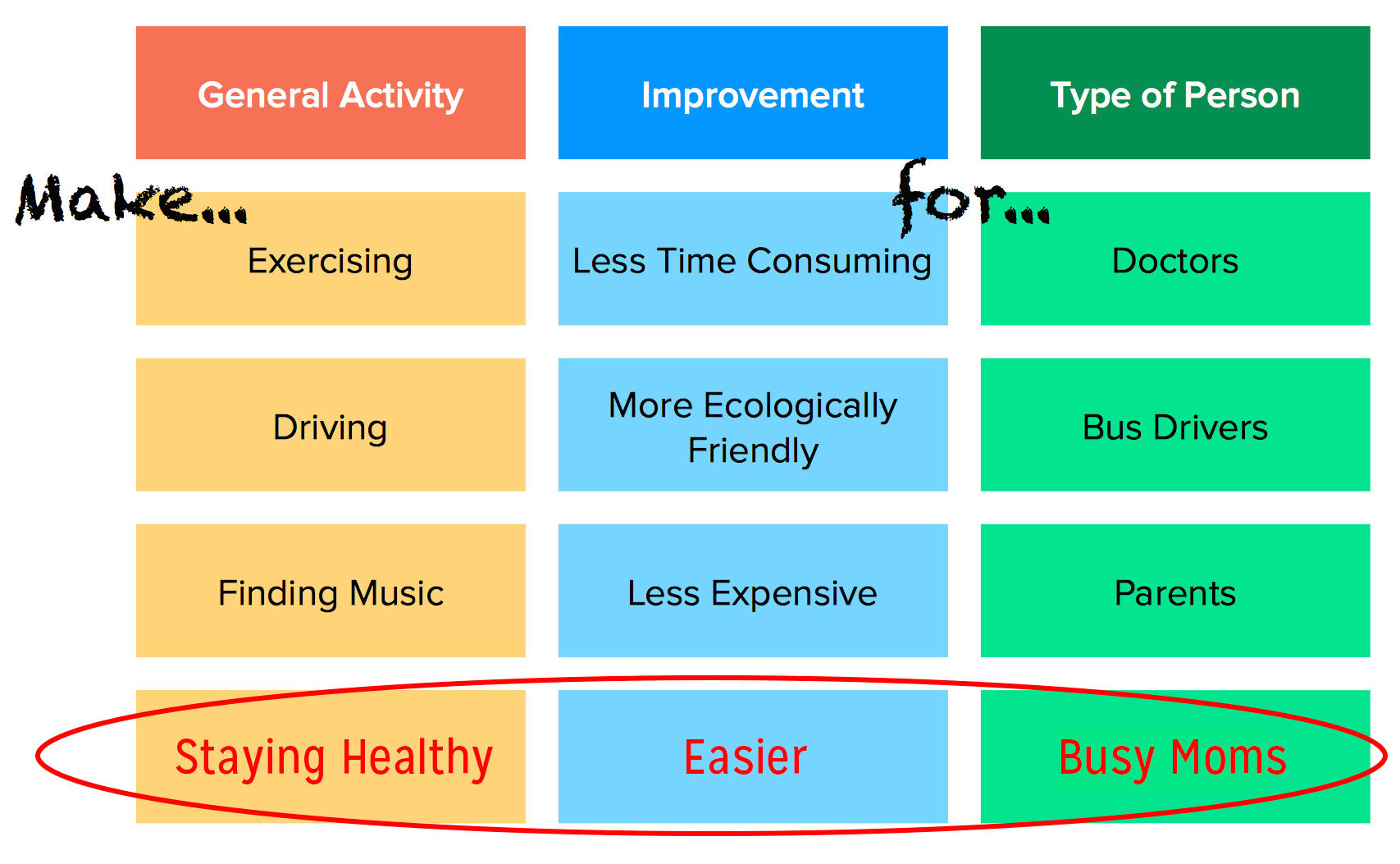Objective
Choose a challenge, or problem to solve. Learn about your audience and find needs to address.
Responsibilities
Exploratory research (field observation and interviews), need-finding, affinity diagramming, idea definition, personas, vision statement.
Need Finding
Conceptual Design Challenge
To come up with a research topic, we brainstormed a list of ideas.
My four-person team chose "make staying healthy easier for busy moms."
We then sought to immerse ourselves in the related context. Questions we considered:
- What do you want to make better?
- For who?
- What are the main things you want to learn? Where will you go? Why?
- What questions will you ask?
Exploratory Research
We set out to conduct research in order to discover potential user needs and focus our idea.
Field Observation
Prior to field observation, we defined the main scenario we wanted to learn about. We wanted to see busy mom's in one of their "natural habitats" -- the grocery store. Each member of my team conducted observations (and subsequent interviews) over a week's time on varying days and times.
I conducted my field observation on a Sunday afternoon, assuming it was a common time for people to run errands in preparation for the upcoming week.
Observations at Costco
I walked around observing and photographing mothers as they shopped. I could assume these women were mothers based on one of two things: they had children with them, or they had child products in their carts (children’s books/clothes/toys, gummy bears, Danimals yogurt, etc.)
For the most part mothers gravitated towards products that seemed to advertise “natural” ingredients, or were low in calories or “guilt free.” They also favored sweet baked goods that seemed healthier (muffins instead of cakes and cookies). I observed some moms purchasing frozen or pre-prepared foods, but even then they chose fish over other meats, or egg whites over whole eggs. Kid-friendly foods like Danimals yogurt, or applesauce were a common item. Overall, easy-to-prepare foods were favored.
Examples of products selected:
- Angie’s Kettle Corn -- all natural ingredients
- Oat Fit -- “indulgent taste without the guilt,” 100 calories, with flax
- Cartons of egg whites
- Frozen tilapia
- Freshly baked muffins
- Danimals drinkable yogurt
Interviews
We each conducted interviews in addition to field observation. I conducted my interviewing at a large inner-city Chicago grocery store chain, Mariano's and in a suburban Costco. In all, despite the fact that we interviewed people at different locations in Chicago and the suburbs, there were a few common threads between our subjects that stood out:
- Staying healthy is hard work
- Staying healthy takes a lot of time
- Exhaustion from work or homemaker duties prevents moms from making healthy choices
- Having to accommodate for picky eaters makes staying healthy more challenging
Research Synthesis
Affinity Diagramming
We took our insights from our research and pulled out keywords from our notes. By lumping these words and phrases together via affinity diagramming, we were able to start making connections between needs of mothers and problems they needed solved.
Personas
Based on our research and synthesis, we created three personas to focus on:
- A young working single mother
- A freelancing new mother
- A stay-at-home suburban mother with several children
While these personas come from different socio-economic backgrounds, they share commonality in their desire to become healthier in a way that will not be too difficult or time-consuming so they can focus on other obligations.
Sparking a Solution
Our research and defined personas let us narrow our focus even more. We created a Spark Frame to outline the one overarching problem we wanted to solve first, and potential solutions.
Based on our Spark Frame, the two main obstacles for this target audience are knowledge (what's healthy, what's not), and available time (moms of newborns don't have a lot of time for comparison shopping).
Our original idea, "make staying healthy easier for busy moms," had now become "make comparing food healthiness less complicated for moms of newborns."
Complete Solution Brainstorm List
- app, where you scan a bar code, and get a green light or red light whether it meets health criteria - augmented reality?
- organize group meets to share recipes where a nutritionist is involved
- open a grocery store where the brand and products are curated - less options, more structure
- family-centered pre-made meal sales - storefront
- family-centered weekly food delivery service via online - healthybox
- give nutritional score/breakdown at the bottom of a receipt after purchase
- change food labeling
- change food organization within the store - expedited healthy essentials
- online shopping experience catered to health conscious moms and allows comparison
- book
Our favorite ideas were the ones in italics. But with those ideas, came a few concerns we would have to keep in mind if we took this project further:
In implementing the augmented reality app we would need to keep lower income moms in mind (like the Valentina persona), so perhaps in addition to a smartphone app there could be a few scanners installed in the store that would serve the same purpose.
The nutritional score would be good validation for those who strove to make healthy decisions when shopping to know what they bought in fact is nutritious. But for those that don't know much about nutrition to begin with, it's not that helpful. They would need something in addition to a nutrition score on their receipt -- maybe if your "score" on the receipt is low, it would also then offer suggestions for alternative healthier products that are similar to the unhealthy ones they bought.










